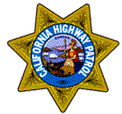

CHP RADIO SYSTEMS
PART ONE
1938-1962
This Part One web page primarily covers California Highway Patrol radio equipment used in the patrol cars from 1938-1960. There are separate web pages for the motorcycle equipment and the equipment used from 1960-present.
INTRODUCTION
Information on the earliest years of radio in the California Highway Patrol communications system is scarce, so if you can share anything, please contact me !
CHP Chief E. Raymond Cato approved a number of early radio experiments in the summer of 1931 to evaluate the feasibility of dispatching patrols by radio, with favorable results, however it was not until some years later that radio equipment was formally and uniformly placed into most of the patrol's fleet. In 1935, the CHP completed its first transportable radio station, a mobile unit built into a trailer with the callsign KAPA. It was described in the April, 1937 issue of Highway Patrolman magazine, and was used primarily as a method of bringing radio coverage to areas in need of it on a temporary basis, such as the site of natural disasters, etc.
This trailer went through a number of different equipment configurations. A 1937 photo of it, shown in the new book California Highway Patrol by Rick Mattos, shows a National NC-100 receiver (for monitoring other base transmitters, incorrectly described as an HRO by the 1937 author) and a home made rack and panel transmitter. The CHP began with one-way radio, i.e. receive only, in 1936, initially using modified automobile broadcast radios and later Philco and Galvin (Motorola) police receivers, which were themselves essentially modified car broadcast radios.
The first base station transmitters for the CHP, including that in trailer KAPA, were home-made by George Moynahan, amateur radio operator W6AXT, who was the son of the deputy chief of the highway patrol at that time, assisted by Communications Division employees Tom Oates, Jim Allen, Marv Carmin and several others. Funds were scarce due to the depression, and the CHP had little money to finance construction of transmitters, so they were hand-built with parts funded by donations, raffles and fundraisers held in the particular counties where the stations were to be installed. The transmitters came in three models: a 500 Watt, a 1,000 Watt and a 2,500 Watt AM version. The stations initially operated on 1682 KHz and later, during the War, a secondary frequency of 1690 KHz was added. Los Angeles County had three of the 500 Watt stations in use. One of the first stations was located on an oil derrick in Baldwin Hills, California !
The CHP did not have station transmitters in place to cover the entire state prior to WWII, particularly in the "experimental" years of 1933-38 . In many areas, the CHP shared the dispatch services used by local agencies, including sheriff, police and even fire departments, and these local agencies would often relay messages to CHP units, while also dispatching their own officers, on the same channel. Up until the early years after WWII, many rural and small town areas had police station transmitters on frequencies other than those mentioned above, and CHP vehicles were listening on the same local channel as mentioned. In turn, those CHP patrol cars with FM transmitters were transmitting on a different 30 MHz frequency, that was used by the local system rather than one licensed to CHP. For example, in Santa Barbara, CHP vehicles shared the county radio system which dispatched all cars on 2414 Kc/s AM and listened for cars on 30.58 MHz FM, at least through the war years. Santa Barbara installed a 1000 Watt daytime / 500 W night home made transmitter on 2414 Kc/s AM in 1940 to replace an earlier one installed in 1933.
In the spring of 1941, the CHP ordered 70 mobile FM transmitters from Galvin Mfg. Co. (Motorola) to add 2-way capability. Forty of these transmitters were placed in use in cars in the San Francisco Bay area from Santa Rose to San Jose, including bridge patrols, with the rest being used throughout the state. (APCO Bulletin, November 1941.) These Motorola "Deluxe" line FM transmitters were a single channel unit, tuned on the CHP frequency of 39.78 MHz, and were added to the existing "1 way radio" cars. (Until the late 1940's, the 42-50 MHz range was allocated to FM entertainment broadcast). Five mountaintop automatic relay stations retransmitting the car signals to the stations on 117 Megacycles were in place by November, 1941.
After the events of December 7, 1941 and formal entry of the United States into the war, funds were made available to the CHP for increased radio presence, as well as adding two-way capability to all cars. In mid 1942 the CHP contracted to purchase 369 additional FM transmitters for the patrol cars, as well as 41 additional medium wave patrol car receivers and 210 additional motorcycle receivers. Those transmitters appear to have been supplied mainly by Motorola with a number of GE and RCA units also being purchased, probably due to wartime shortages and allocation of priorities. The type of medium wave patrol car receivers purchased is unknown although they are believed to have been Motorola Police Cruiser models, either the original pushbutton models or the crystal controlled version (P69-13.) The funding also allowed expansion of the CHP's 118 MHz mountaintop relay system, which forwarded the 39 Megacycle FM signals from distant patrol cars to the dispatch points in a few urban centers such as Sacramento.
The APCO Bulletin for February, 1943 provides some useful statistics on the CHP's use of radio as follows: In October, 1942, CHP's radio system still consisted of 9 land stations, 488 patrol cars, and 434 motorcycles. All mobile receivers were AM medium wave one-way (receive only,) with the exception of 76 two-way "FM" patrol cars in operation in the Los Angeles, San Francisco and Sacramento areas (as mentioned above.) As mentioned above, where the CHP did not have land stations within range of their patrol cars, approximately 35 municipalities cooperated by supplying radio service to CHP mobile units via their own systems (it is thus assumed that those municipalities also shared the CHP channels.) Apparently the equipment ordered in mid 1942 had yet to be installed!
Shortly after 1945, the CHP purchased substantially more base station equipment, from a variety of manufacturers. One of the more interesting of these was the Robert Dollar Company of San Francisco, which sold the CHP a number of 200 Watt class transmitters which contained a pair of receivers as well, all in a six foot rack cabinet. At least one of these transmitters has survived, in near mint condition, and is in operation on the amateur 160 Meter band today.
After World War II, the CHP generally followed a policy of keeping a piece of equipment in service for almost exactly ten years. There were some exceptions to this rule which shortened that time span, such as when the auto industry switched to 12 volt cars and when the FCC switched mobile radio systems to mandatory "split channel" narrow band operation.
The CHP's radio equipment was maintained by radio service facilities operated by the State of California throughout the state, under the Department of Finance, Division of Communications. Initially, these service shops were located in Sacramento, Los Angeles and San Francisco, and dealt almost exclusively with CHP radio equipment. Later, as other state agencies became radio equipped (such as the California Division of Forestry,) they would also maintain and upgrade equipment for those agencies, and many more shops were constructed throughout the state. Eventually the radio maintenance division came under the newly formed State of California Department of General Services, or "DGS." Today, all radio equipment used by California state agencies is maintained by the State of California DGS Telecom Division.
THE FIRST MOBILE INSTALLATIONS, 1938-50
The first mass-scale mobile radio installations in the late 1930's used "medium wave" receiving equipment supplied by Philco, and later, Motorola (Galvin). Both models were modified car broadcast radio designs. The Motorola set was the P-69-14 "Police Cruiser", and the Philcos are believed to have been the DPV, 821PV and 822PV models. Both the Philco and Galvin sets were tunable. The Philco set tuned via a speedometer-style flexible drive cable which connected to a small chromed control head, which also contained an on-off switch and a red pilot lamp, apparently identical to their broadcast radio head other than the dial scale. The Galvin set was also tunable, but in addition had 6 preset channels, which were selected by a somewhat temperamental cam, motor and solenoid arrangement, shown on the separate Motorola Early Equipment Index web page.. The Philco sets tended to drift (in frequency) more than the Motorola sets. The DPV was Philco's first mobile police receiver, followed by the 821PV and 822PV respectively. Although not used by the CHP, Philco also offered single channel crystal controlled versions of the 821 and 822, namely models 821P and 822P, probably as an alternative to the drift-prone variable tuning models. All of the Philcos as well as the Motorola receivers were powered by a 6 volt input vibrator power supply. In general, the antenna used was a broadcast type telescoping whip on the left side of the vehicle. The receivers were mounted on the firewall under the car dashboard. However, by 1948, the CHP had purchased a number of Motorola "Police Cruiser" P-69-18 SP2 receivers, which were a special model of the standard P-69-18 Police Cruiser crystal controlled receiver featuring a trunk-mounting adapter box which duplicated the connectors found on a Motorola "Deluxe Line" FM receiver. The P-69-18SP2 receivers were mated to a variety of transmitters, as listed below, and located in the car trunk.
As mentioned above, two-way capability began to be gradually added to most cars (but not motorcycles) on an experimental basis in 1941 and then extensively by 1943. This was accomplished by adding a VHF FM transmitter, the Motorola FMT-30(D) dynamotor powered "Deluxe" line equipment, in the trunk of the patrol car, along with a separate transmitting antenna on the left side of the rear fender area. Approximately 200 of the vibrator powered Motorola FMT-25(V) transmitters were also purchased, which were the same as the FMT-30(D) mentioned above, other than having slightly less output power. The CHP also purchased GE 4TSA- series and RCA CM-1 series FM VHF transmitters, in smaller quantities, sometime between 1945-48. These "two way" cars were readily identified by two radio antennas: the rear fender "tripod" mounted Motorola antenna being used for transmitting (later the ball and spring style) and an "extra-long" broadcast style whip on the front fender. The car transmitting frequency was 39.78 MHz FM, statewide. The medium frequency AM Philco or Galvin receiver was retained, and the system was, for all intents and purposes, "full duplex." The most common early installations used a handset rather than a microphone. By 1950 the Link 205 and Motorola Police Cruiser P69-18SP2 receivers were also in use.
The CHP never used AM transmitters in any of their vehicles; the first mobile transmitters were FM and the system performance was significantly better than the AM systems in use by most other law enforcement agencies at the time. In some vehicles, such as those used by high-level officials in the CHP, and in the governor's limousine, a Motorola 39 MHz FM receiver was also installed, evidently to allow direct car-to-car operation between them and other cars similarly equipped. That receiver was the FMR-13V, Motorola's intended match for the FMT-30D transmitter.
Police Cruiser Tuning Head:
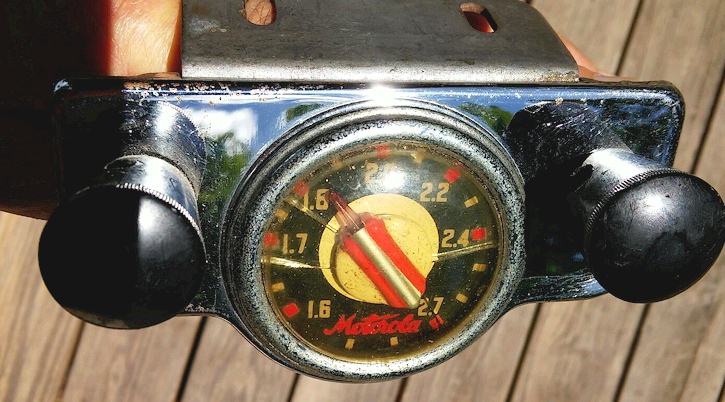
Please note that the transmitter above uses a Carter dynamotor. The earliest versions of this transmitter used a much larger, round dynamotor. The CHP also used the FMT-25(V), which had a vibrator power supply where the dynamotor is shown in this model above. See below.
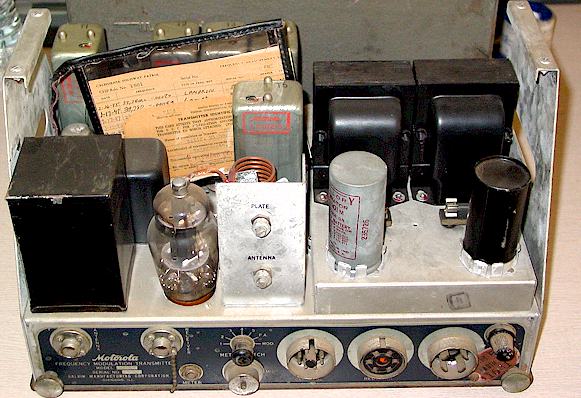
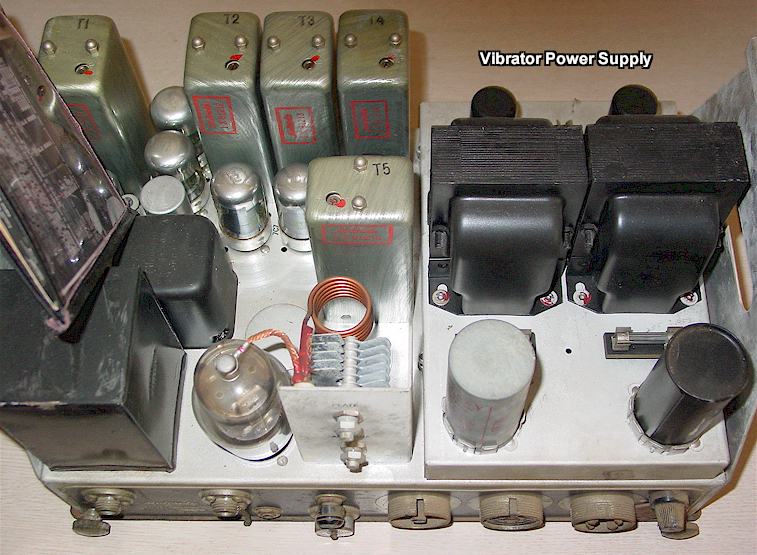
At this time period (1941-1951 more or less,) CHP used metal property tags as shown below:
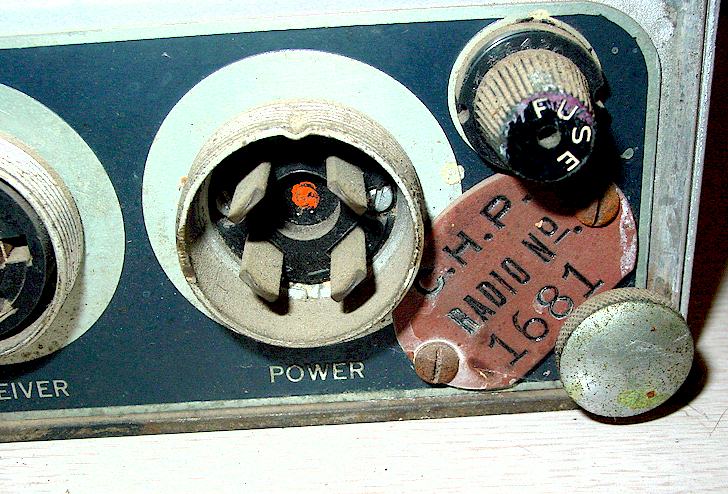
Rather poor photo of interior of 1945 era CHP car shows handset in use but no detail of rest of control equipment. From Motorola advertisement in APCO Journal.
Note that between 1945-1963, the CHP used a wide assortment of radio equipment from several manufacturers, and kept it in service approximately 10 years, despite how obsolete much of it was by that time considering how fast the state of the art was changing. During the period from 1938 through 1963, the CHP never bought a fleet wide radio contract but rather bought radios in modest quantities every few years. Thus a car could have had a Motorola, RCA, GE or Link radio. By the end of the 1950's the newest radios installed in cars, now that the system was all VHF, were Motorola "Twin-V" and GE "Progress Line" mobiles. These would be phased out by the mid 1960's in favor of either the RCA or Motorola "standard" new radios which were made to identical specifications and were operated the same way.
SUMMARY OF MOBILE TRANSMITTERS IN USE BY CHP AS OF 1945
CHP placed a consolidated FCC license copy inside each mobile transmitter which listed all the mobile equipment the agency had in service at the time of the license. This gives a useful list of all the mobiles in use at the time for historical reference. The list as of late 1945 as seen on this license:
Number in Service Make Type Power Output
2 Air Associates (Motorcycle) UMT-30M 6 Watts [ Experimental]
3 Link Radio 25-UFM Ed. 2 25 Watts
271 Motorola FMT-30D 30 Watts
170 Motorola FMT-25VW 25 Watts
3 Link Radio 50-UFM 50 Watts
1 RCA CM-2A 60 Watts
15 Motorola FMT-25V 25 Watts
It can be seen that the most common transmitter in use in 1945 was the Motorola FMT-30D, and the FMT-25V series. The purchase of radio equipment would increase dramatically after the war and would include GE equipment for the cars and Avia equipment for the motorcycles.
EXPERIMENTATION
Throughout its history the CHP has always experimented with new technology. Some of it gets adopted quickly while others are ahead of their time by decades. Shown below is one of the earliest experiments with a "dash camera," believed to be from the late 1930's, from a magazine article. I don't have the name or the issue date.
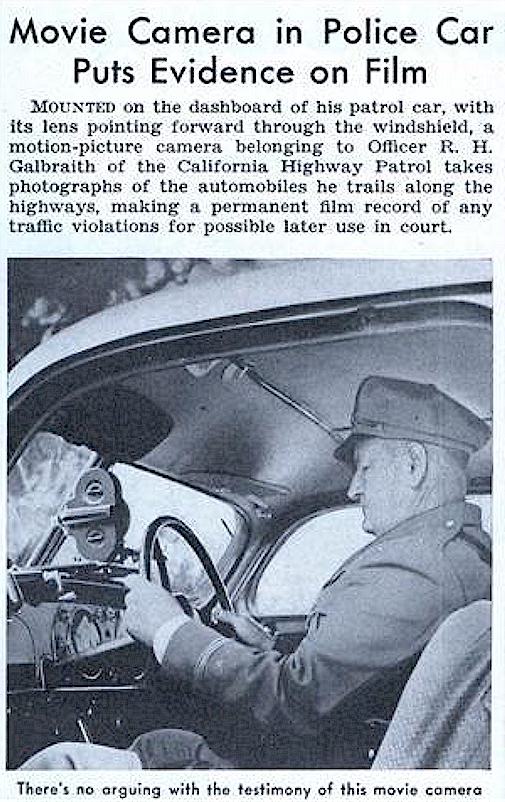
THE SHIFT TO VHF DISPATCHING, 1950
In approximately late 1950, the CHP began moving all operations to VHF, and discontinued dispatching on the old 1682 and 1690 KHz AM channels. Those frequencies were then retained for point-to-point land station intercommunication, for at least several years afterwards. The changeover to VHF was not apparently uniform because there are photos of cars as late as 1955 still containing the single VHF FM transmitter and an AM medium wave receiver. There are also photos of older patrol cars with the medium wave receiver antenna snapped off, suggesting that those cars had finally been converted to VHF. It is presumed that until the changeover could be fully completed, the station broadcasts were simulcast on both medium wave AM and VHF FM.
The car photo below shows a 1949 Ford patrol car outside the Newhall, California CHP station sometime between approximately 1950-1953. I suspect this photo was not later than 1953 as the 1949 cars would have been "run out" by about that time and ready for surplus sale. Note the dual antennas still mounted. The ugly front fender antenna would be for the AM medium wave Police Cruiser or Philco receiver, or possibly a Link Radio 205A (see below.) The rear antenna is for the VHF FM transmitter, and in some installations for a VHF two-way set, normally used in areas where VHF dispatching was now available. After the VHF dispatch transmitters went into use, VHF receivers or completely new VHF sets were retro-fitted, and the old medium wave antennas were just left on the cars. As mentioned above, some photos from 1953 show the rods of the antennas torn off but the insulators and bases still present. This car may have still had the medium wave AM receiver in it, during the change-over period. Too bad we can't have a look inside!
Photo credit Debra
DiPrimio, Santa Clarita 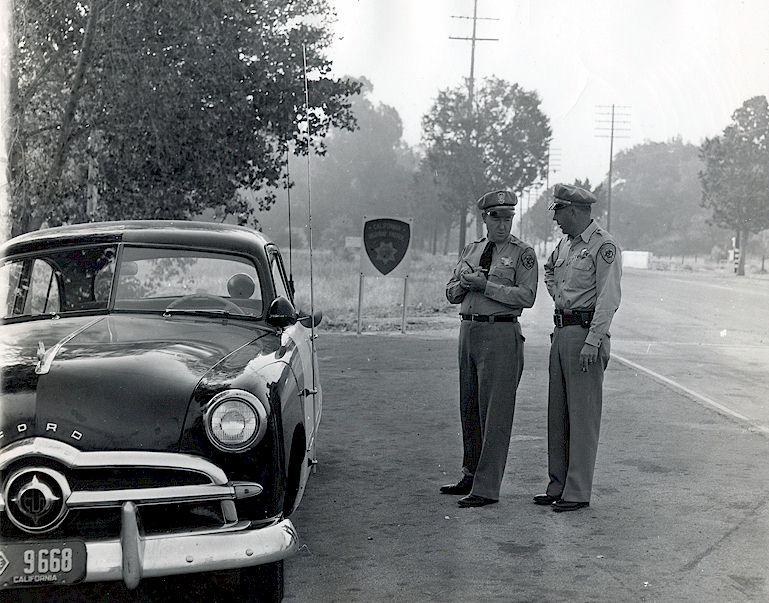
GE Equipment
1946 Evaluation Purchase: Sometime in 1946 the CHP added GE mobile VHF FM transmitters to the fleet, but no in large quantity. These were the GE 4TMD series transmitter, actually developed in 1942 as shown on the left below. The unit on the right is a receiver, not used by CHP.
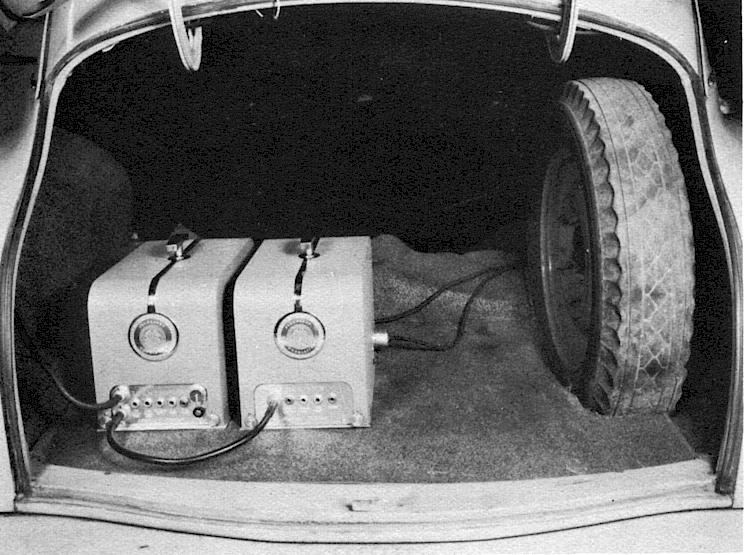
An unusual photo is shown below. This is a 1955 Buick, in 1955, but contains one of the early 1946 purchase GE VHF FM transmitters, and the absence of a receiver in the trunk indicates that this car was still being dispatched on the 1682 kHz AM frequency! Common belief is that CHP had transitioned to all VHF operation by 1951, but obviously not so!
The first major order of new style all-VHF FM two way radios was with GE. The equipment operated on a single new 42 MHz FM channel pair, common statewide, later referred to as the "Blue" channel. These were two piece sets. They were commonly referred to in the mobile radio industry as "8th MO" and later more commonly as "Pre-Progress Line" (starting in approximately 1945, a quantity of two piece GE sets which pre-date these units were purchased to evaluate the GE product.) The Pre-Progress GE radios were very reliable, well liked, and many remained in service into the early 1960's ( when they were hopelessly obsolete.) Use of the old 39.78 MHz car-to-station frequency was gradually discontinued during the changeover to VHF dispatching beginning in 1950, and replaced by the new statewide 42 MHz channel. During the change-over period, it is presumed that CHP stations were listening on both the 39.78 and "Blue" car to station frequencies until all cars had the new 42 MHz equipment and were transmitting on 42.18 MHz.
The GE radios were shipped and installed during the 1950-52 period.
GE Transmitter
Photo below shows GE Pre-Progress "8th MO" equipment installed in 1955 Buick patrol car
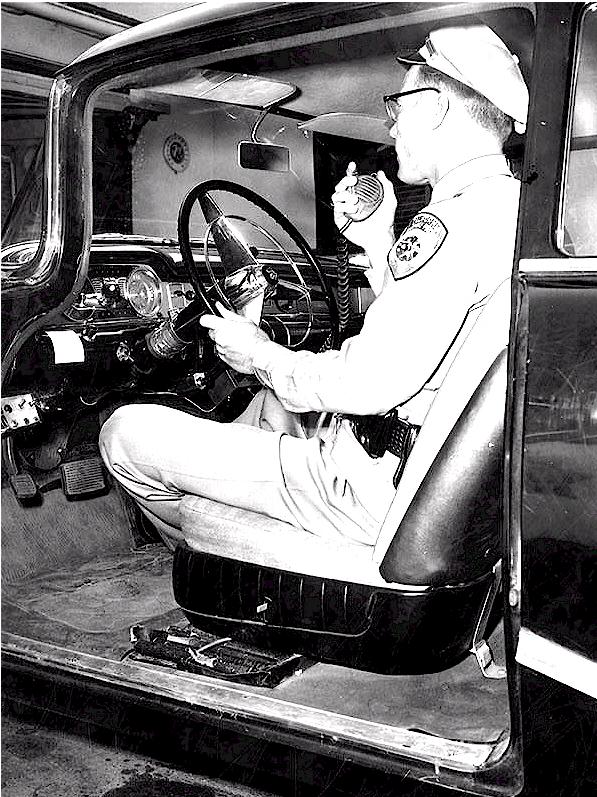
Note one microphone mounting location, 1959. This is a poor choice as the sun will heat the metal microphone up and burn your hand! :
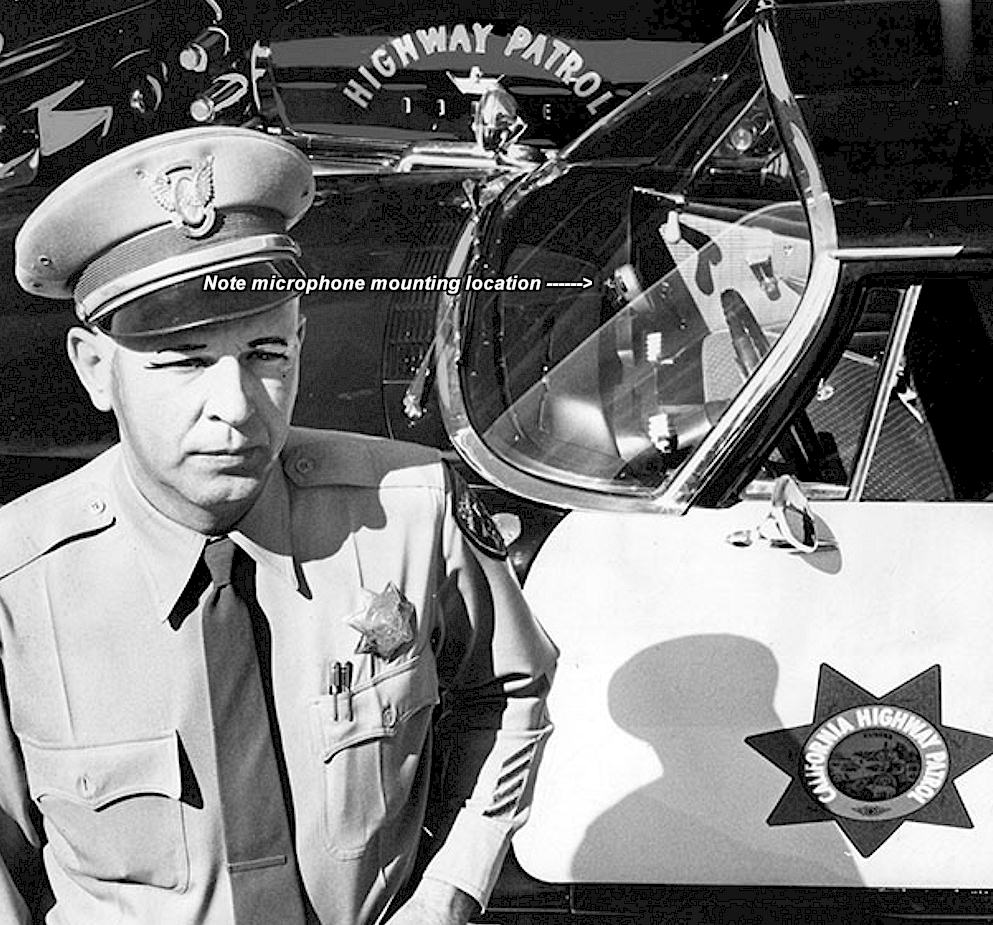
RCA Equipment
At least in the northern California area, the GE radios of 1950 were supplemented at the same time by RCA "Fleetfone" sets of the CMV-3 series, a 60 Watt one- piece chassis unit of equivalent performance to the GE equipment. It is estimated that the new 1950 radio fleet consisted of 70% GE Pre-Progress sets and 30% RCA "Fleetfone" CMV-3 sets. It is believed that all of this equipment was supplied with microphones rather than handsets. It is also believed that these radios had single frequency receivers and two frequency transmitters, to allow "car to car" traffic on the dispatch channel as necessary. The control head below should have a toggle switch on the bottom surface to select the transmitter channels.
From approximately 1955 to 1963, the CHP supplemented the GE and RCA sets of the 1950-53 deliveries with a variety of standard off-the-shelf radios, bought in moderate quantities, rather than ordering a single type in large numbers as we will see they did with Motorola and RCA in 1963. See below. Some of the two-piece "Pre-Progress Line" mobiles were replaced beginning in approximately 1955 by GE "Progress Line" one-piece 6/12 volt mobile equipment, model MA/E-17, as well as a number of Motorola 15" inch width one-piece "Twin-V" mobile radios. It is presumed the RCA Fleetfone series equipment was gradually retired as more 12 Volt cars entered the fleet from 1956 onward. The 1955 Buick patrol cars were a problem because unlike other manufacturers, Buick had already switched to a 12 Volt system in 1953. The Ford and Mercury systems remained 6 Volt until 1956.
Below is a view of a somewhat shabby RCA Fleetfone control head as above:
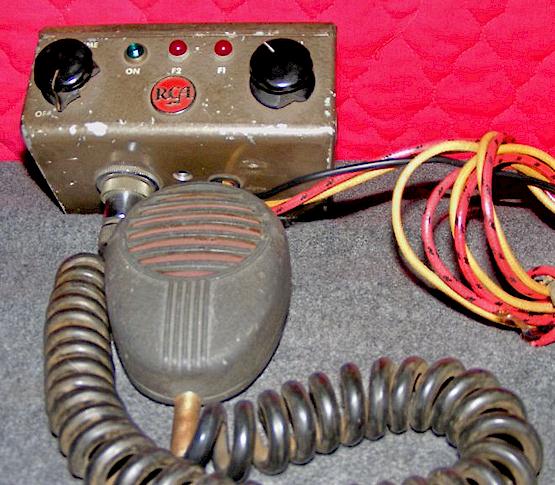
The first Pre-Progress Line GE's and the Motorola Twin-V's continued in service through at least 1963, as did the Progress Line (below.) The GE equipment was eventually field modified for 12 Volt operation as 6 Volt cars were surveyed. It appears that the CHP went to the trouble of modifying most of the GE Pre-Progress mobiles to 12 volt operation as the cars were replaced, rather than purchasing all new radios.
Interior View of 1952 Patrol Car
CHP cooperated in the production of a late 1952 film indirectly concerning traffic safety, entitled Devil Take Us, about the consequences of reckless driving, starring among others, real traffic officer Del Kuhn with a real CHP car. In that film there is at least one view of an actual installation in a patrol car, probably a 1951-52 Dodge or maybe an Oldsmobile, as shown below. To the left is the RCA control head for the Fleetfone radio. There is a 2-channel switch on the left side of it for car-to-station or car-to-car. The louvered box on the transmission hump is a Link Radio Co. 205A medium frequency receiver, possibly on the old 1682 kHz AM dispatch frequency oir the local county's dispatch system for police and sheriff, and the control head for it is on the right. This style 205A was made between 1946-1950. Evidently whatever area this car covered either did not have full VHF FM dispatch in use yet, and the Link receiver was still used to receive broadcasts on the old frequency, which were simulcast with VHF FM during the change-over years, or as mentioned above, was tuned to the local system. . By approximately late 1953 the medium wave AM system should have been decommissioned and the Link set would have been removed. It is probable that other cars had the GE Pre-Progress mobile radios as above, with the Link Radio 205A shown here. Again, police and sheriff stations in some areas shared the 1682 kHz dispatch system with CHP or used their own frequency, and CHP cars were dispatched by non-CHP transmitters, and those remained in operation in some areas of the state for a short time after the CHP itself abandoned the frequency. Interoperability in 1950 that has yet to be equaled in 2017!
The Link Radio receiver was originally intended to be mounted on the firewall, but I am guessing that by the 1951 or 1952 cars, the firewall space was no longer large enough to allow it to be mounted there, the heater and defroster now being in the way. Of course the receiver could have been mounted in the trunk with a longer cable to the control head (the standard Link 205 cable was only about 2.5 feet long.) I am guessing that since the receiver was only temporary to provide full coverage while the VHF FM system completed its build-out, it would have been removed not too long after the car was in service, anyway, at least by 1956-57. By this time it is believed the coiled cord would have led to a microphone and not a handset, as was typical through about 1946.
If you find a video file of this film, please let me know!
Photo courtesy CHP 1010 website
and Del Kuhn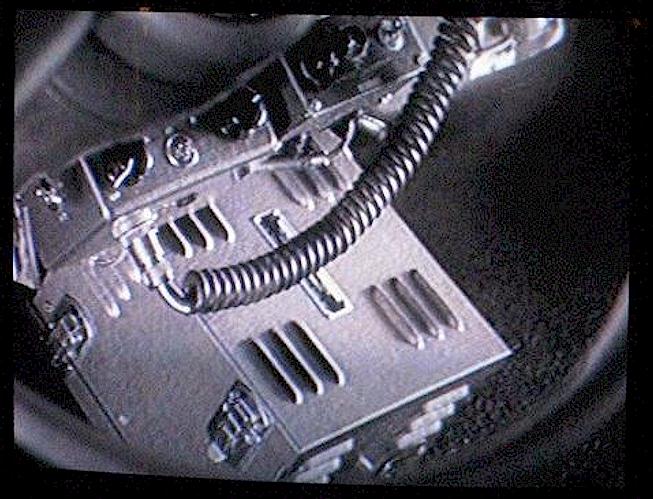
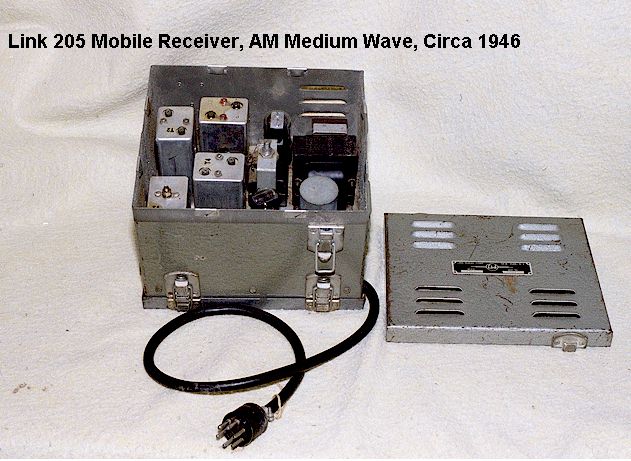
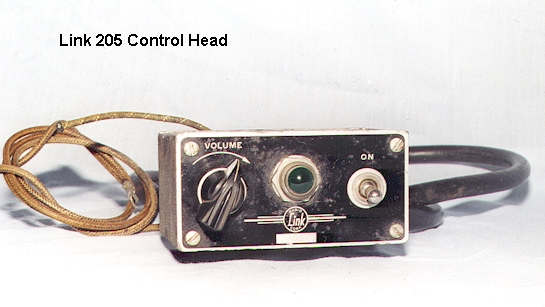
ANTENNAS AFTER 1950:
Shown below is a GE antenna supplied with the Pre-Progress radios above. Note the barely visible "General Electric" logo molded into the base disc. The ball is die cast. This antenna was used on the patrol cars from 1950 through the end of stock, probably in the early 1960's, when it was replaced by the Antenna Specialists "black ball" mount shown below it. The GE part number was 4033101-G1 and GE was supplying them off the shelf at least as far back as 1946. It is believed that these were manufactured for GE by the Ward Mfg. Co. of Cleveland, a maker of auto radio antennas. Note that the coaxial cable in the photo below is newer than the antenna assembly and not the original, which would have been RG-8/U cable. Note also that at least one other style of antenna was in use, presumably on cars containing the RCA radios, which was supplied by RCA. It looks almost identical to the GE part shown below except that ball is painted black without a ring at the parting line, and the spring has no hex flats on it. (photo to follow.)
Photo courtesy Alan Freeman
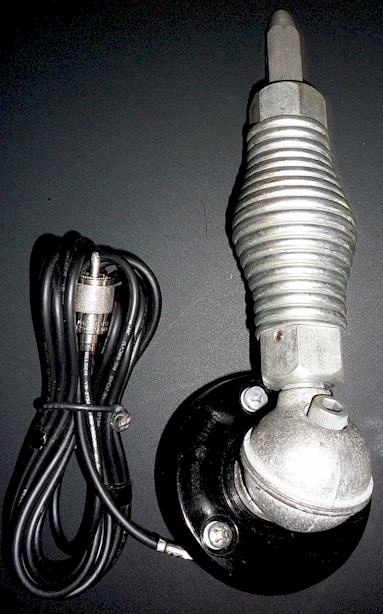
EQUIPMENT ADDED AFTER 1952
The initial purchases of the "new" all VHF FM equipment were the GE Pre-Progress radios and some of the RCA "Carfone" equipment as described above. Throughout the rest of the 1950's, the CHP purchased modest quantities of newer equipment to supplement that already in the field. This was partially because cars were constantly being added to the fleet, and also that American cars changed over to 12 Volt systems for 1956, and much of the older equipment was incapable of operating in a 12 Volt car without expensive modifications. From approximately 1952 through 1963, the CHP also bought Motorola "Twin-V" and GE "Progress Line" mobile radios as supplements to the radio fleet. After 1963, the CHP had made large scale purchases of a single type of standardized radio from RCA and Motorola, and the radio fleet was then standardized, as they still do today.
Thus, it can be seen that from 1952-1963, CHP had a broad variety of equipment by RCA, Motorola and GE, all in use at the same time. There was no single type or model of radio in use during those years.
GE PROGRESS LINE Equipment, 1955-60
Beginning in about 1955, the CHP supplemented the radio fleet with the "new" Progress Line mobile radios, a vibrator powered one-piece unit which replaced the discontinued Pre-Progress series, as it would now come to be known. About late 1959, a quantity of GE Progress Line model MT17N CPM312 mobiles were also purchased, which were the last version of the Progress Line, and featured a transistorized power supply for 12 volt operation. Those continued in service for a number of years, after 1963 possibly mainly in administrative vehicles rather than patrol cars. It is believed that all the Progress Line MT17 mobiles were retired when delivery of the 1966-contract RCA and Motorola fully solid state radios was completed, and that after 1963, the only radios being purchased by CHP were the RCA and Motorola specially made sets. A recent book on "State Police Cars" contains a photo of the interior of an early 1960's CHP patrol car, probably 1962, showing a late Progress Line control head in use. Another photo, too poor to reproduce here, shows a Motorola "T-Power" style control head, which would have been used with the last generation 15" case "Twin-V" radio drawer, probably delivered between 1958-1962.
Thus, it can be concluded that the period of 1950-1963 is somewhat of a mess regarding what equipment was in use at any particular time. Rather than buying one or two models of equipment in a large quantity and standardizing, CHP bought a variety of equipment throughout the time period. By 1956 the equipment in a CHP car could have been the GE Pre-Progress, RCA, Motorola Research Line, Motorola Twin-V or GE first generation Progress Line. CHP records show all of such equipment being in use in one place or another.
The photo below shows a barely-visible late 1950's or early 1960's GE Progress Line control head in a 1961 Dodge CHP car. The photo below that, shows a generic GE Progress Line low band mobile.
The CHP control head for the GE Progress Line series is as shown below. Note that the two-frequency S-C-S-C color dot system aluminum overlay (here curiously C-S-C-S) appears to have been added some time after the equipment was in service, based on it covering the "KA4993" decal.
MOTOROLA TWIN-V EQUIPMENT
By about 1954, the CHP was also buying Motorola Twin-V low band mobile radios in the 15 inch case format. At the present time it is unknown in what quantity. An example of such an installation is shown below, dating from approximately late 1962. The large gauge is a Jones Motrola calibrated speedometer, a popular addition to police cars of the era. (Please note that it is Jones Motrola, and NOT Jones Motorola!! )
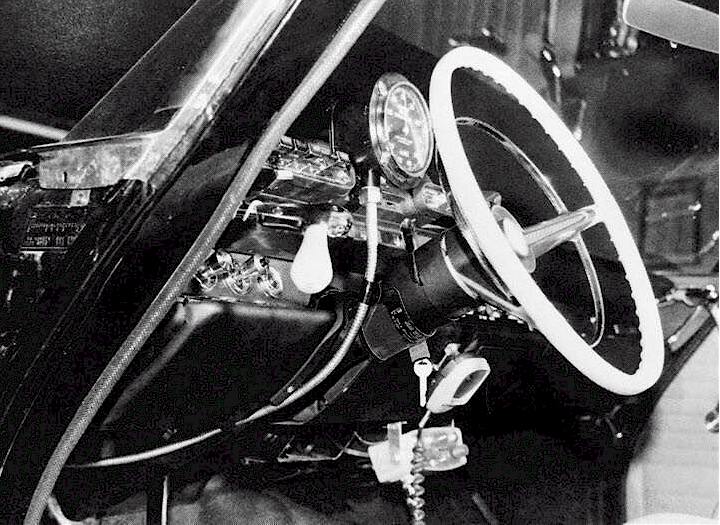
Property Tags
Shown below is the typical 1950's CHP property tag used on radio drawers and some control heads. It is a yellow water-slide decal. Unfortunately most of these were scraped off by people who acquired this equipment as surplus, over the years. This style decal was used from approximately 1950-1962, when it was replaced by a yellow paper self-adhesive label. In turn, the yellow paper label was superseded in the 1970's by a metallized-foil sticker.
Multiple Channels
Originally, all CHP VHF FM radio equipment operated on the same statewide frequency, with a separate "car to car" transmit channel in the mobiles that transmitted on the same frequency as the dispatcher. By the late 1950's, this was becoming unworkable and a few additional frequencies representing divisions within the CHP system were added in congested areas. The system of colors for the various frequencies was formally adopted with the purchase of the 1963 radio fleet, however it had already been in use for a few years before that, where urban areas such as Los Angeles already required additional channels. The GE Progress Line control head shown above is an example of a radio with one color-coded extra channel, in service well before 1963.
RADAR!
While the CHP never adopted radar in the 1950's, because the legislature refused to fund it, they were experimenting with almost all of the new technology being introduced in the 1950's. The photo below shows a CHP car equipped with an Electro-Matic radar unit in approximately 1954-955 at the Newhall, California CHP station. The radar was designed to be used only while stationary, and usually there was a separate chase car to pursue the speeder, directed by radio. The Electro-Matic unit initially used a paper strip chart recorder, but most models would use an analog meter with a pointer-hold feature. The CHP never purchased these units in any quantity, as mentioned above, and this seems to have been the end of the radar experiments until the late 1970's.
An article in the Highway Patrolman magazine from 1955 states that this car was used as an experiment and drivers stopped for speeding were not ticketed but rather given some sort of warning and informational paperwork.
The speed meter can be seen attached to the top of the dashboard in the photo below. The bracket attached to the car looks sturdy enough to have allowed this car to start up and pursue the speeders alone, although as mentioned, a chase car was the normal method used. At about the same time, other state police agencies, such as New York, were experimenting with radar. The New York cars initially used a large older radar unit in the trunk of the patrol car, which required a separate 6 Volt car battery and the trunk lid remaining open during speed measurements. Later, huge holes were cut in the trunk lids and fiberglass panels laid into the holes and painted, so that the lid need not be open. CHP seems to have liked the tubular mast assembly shown below, instead.
The car below, a 1953 Chevrolet, is unmarked with black doors (the antenna and the radar unit would seem a dead give-away!) And what is that on the rear package shelf - - a cover over the amber light?
Photo credit Debra DiPrimio,
Santa Clarita 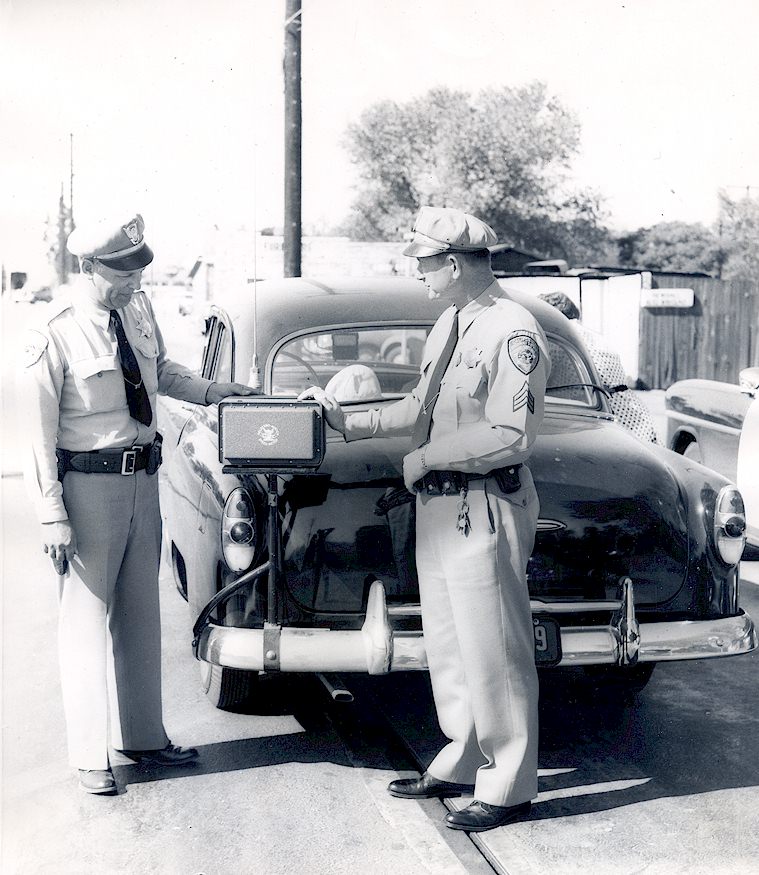
What should be the interior of the car, from a separate source. The radio installation is rather odd since it must have been installed in 1953, yet it consists of the wartime Motorola Deluxe line transmitter and the Police Cruiser P69-14 receiver, quite old by then and more or less at end of service life, and, according to CHP records, medium wave dispatching on 1682 kHz ended in 1950.
Scanned photo thanks to Alan
Freeman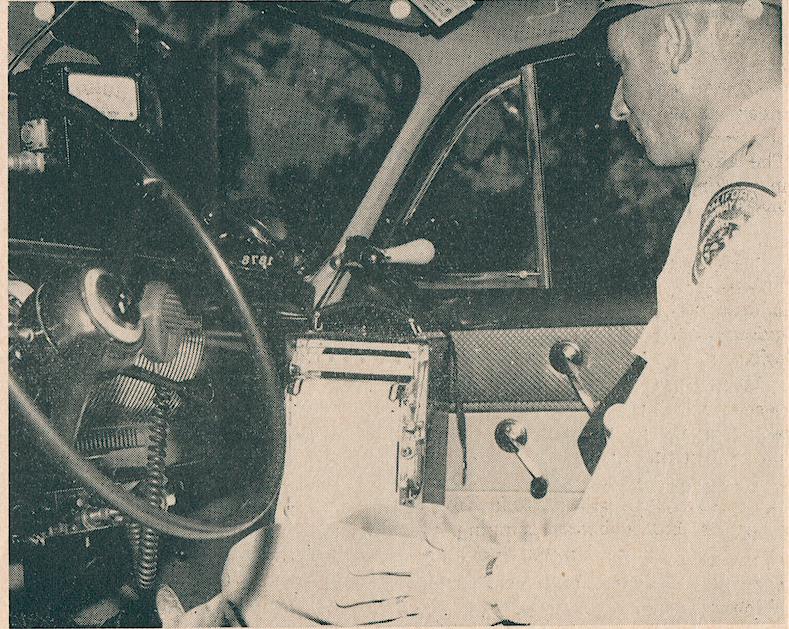
Here is yet another interior photo, this time more clearly showing the Police Cruiser P69-14 control head. The item on the far right is the paper strip chart recorder that printed the speed of the target vehicle (evidence.) The officer is pointing to a speed on the chart with his pen.
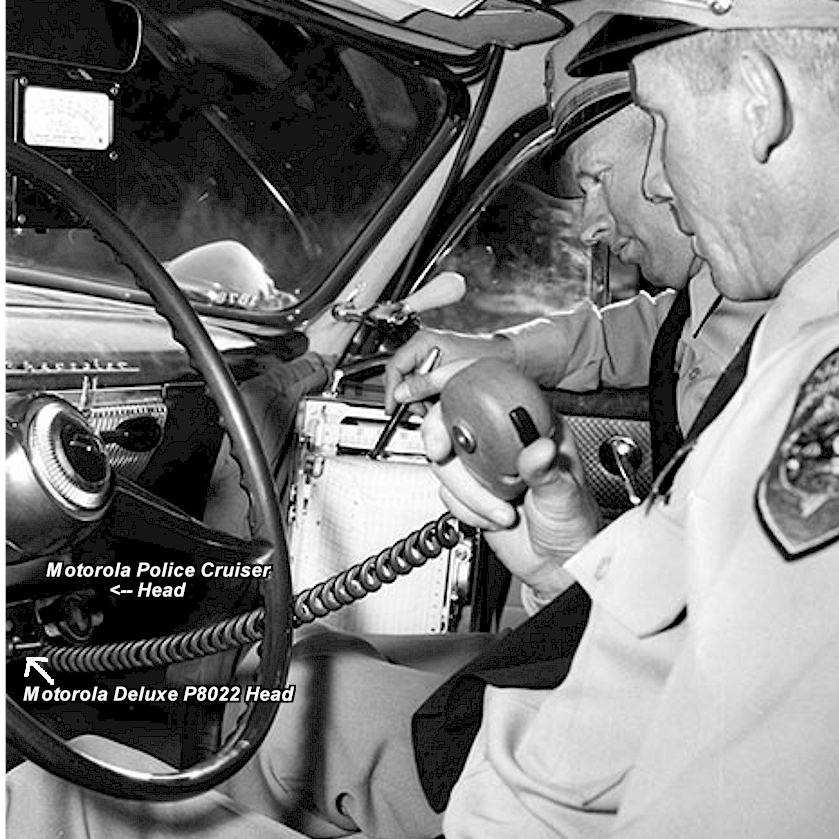
Ver. 8/19/2024 © Geoffrey C. Fors 1998 All rights reserved